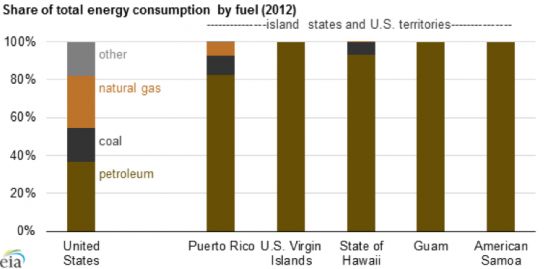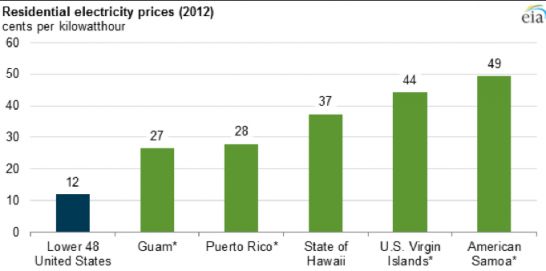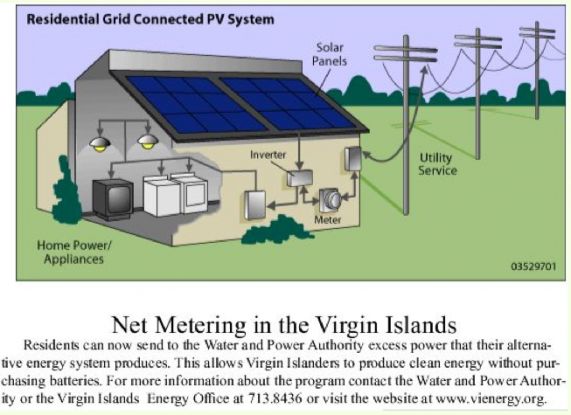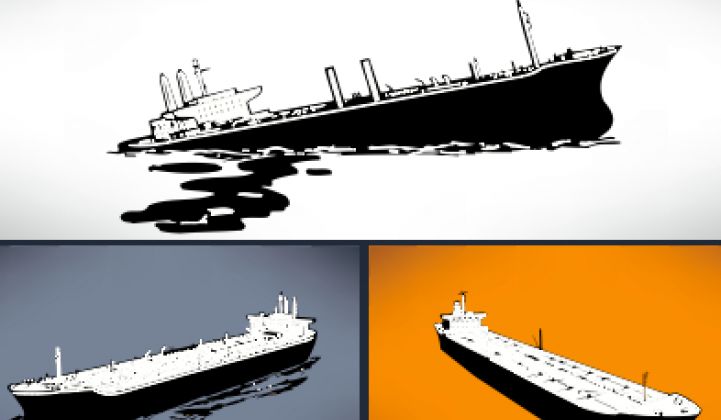Geopolitically and congressionally, the phrase "United States" means the continental U.S., Alaska, Hawaii and the U.S. territories: Puerto Rico, Guam, the U.S. Virgin Islands, American Samoa and the Northern Mariana Islands. (There are also some uninhabited atolls and islands that qualify as territories of sorts.)
Inhabitants of the territories are represented in Congress by delegates, have protections within U.S. courts, and pay some federal taxes.
The 4 million inhabitants of the territories (3.6 million of which live in Puerto Rico) also power their islands almost entirely with petroleum. And because the price of oil is relatively high, residential electricity prices in the territories are three to five times the price of mainland electricity.
One would imagine that the next step in the energy evolution of the islands would be toward renewables such as wind, solar, and geothermal.

Source: EIA
One might be wrong.
Instead, the EIA contends that the diversification of energy sources will be from the increase in natural gas usage, rather than renewables, because "low natural gas prices and new shipping technology may allow these islands to import liquefied natural gas."
Again, residential electricity prices in the territories are three to five times the price of mainland electricity, as shown in the following chart.

David Crane, the CEO of energy giant NRG, recently noted, "With oil setting the marginal price of electricity, retail electricity prices in the Caribbean are among the highest in the world, hindering economic development, job creation, and quality of life. By tapping into each island’s specific, readily available and ample renewable energy resources, we can achieve an immediate and significant reduction of operating expenses, imported fuel cost, carbon footprint and other air emissions and noise pollution."
Puerto Rico
With its 3.6 million residents, Puerto Rico has by far the largest population of any of the territories.
In 2013, 68 percent of Puerto Rico’s electricity came from petroleum, 15 percent from natural gas, 15 percent from coal, and 2 percent came from hydropower, according to Puerto Rico Electric Power Authority (PREPA), the island's utility, which has five main power plants with a capacity of approximately 3,900 megawatts for its 1.5 million customers. Herman Trabish writes in an article at the website Utility Dive that the island's 24-cents-per-kilowatt-hour electricity is largely generated "with oil imported from Brazil."
Two wind farms on the island have a combined nameplate capacity of 120 megawatts. The island has net metering and tax incentives for solar equipment, as well as a 20 percent renewable portfolio standard goal that it is seeking to achieve by 2035.
GTM Research's Utility PV Market Tracker reports that PREPA has only 30 megawatts of utility solar installed, but almost 900 megawatts in its contracted pipeline. (To learn more about the tracker, visit www.greentechmedia.com/pv-tracker.) Even with that pipeline, Robert Sternthal, a project financier, expressed some frustration at the challenges involved in moving a renewable energy project forward on "la isla del encanto."
PREPA is on the verge of bankruptcy and is currently seeking to fill a Chief Restructuring Officer role. Barron's notes that the utility is struggling with $10 billion in debt.
4-step oil-addiction recovery process for Puerto Rico
Energy storage. Grid-scale energy storage could play an important role in helping unstable island grids integrate renewables.
As Jeff St. John reported last year, PREPA set minimum technical requirements (MTRs) that require the 600 megawatts of green power the utility is looking to add next year include energy storage capabilities aimed at helping to stabilize the island’s grid. (These are the same MTRs which frustrated developer Sternthal.) Each project must have enough energy storage to provide 45 percent of the plant’s maximum generation capacity over the course of 1 minute, for use in smoothing out the “ramp rate” of varying sunlight or wind speeds. Each new Puerto Rico project must also have enough storage to meet 30 percent of its rated capacity for approximately 10 minutes or less, to be called on for frequency regulation, or for keeping the grid’s power constant at 60 hertz.
Simplify the process for project developers. Although this MTR seems like it could be a boon for energy storage, it could be a significant headwind for solar and wind projects. As Sternthal noted, "It remains unclear whether Puerto Rico and/or PREPA really want renewable energy, which is troubling, because if renewable energy in Puerto Rico doesn’t make sense, it doesn’t make sense anywhere." He also claims that many of the U.S.’ top renewable players have decided to opt out of developing projects in Puerto Rico.
Jim McDowall, business development manager at French battery giant Saft, expressed an opposing opinion in an interview earlier this year, stating, “I think there’s going to be a domino effect around the Caribbean, when these systems start going in and they’re shown to be financeable."
Liquid natural gas. The current low cost of natural gas has moved PREPA to attempt to diversify its fuel supply and convert petroleum-fired generating stations to use LNG, as well as building out LNG terminals and infrastructure. Political winds are reportedly not perfectly aligned with that outcome.
EIA notes that the development of standardized refrigerated shipping containers "means small amounts of LNG can now be trucked, railed, and shipped like other containerized cargo. Once received, the LNG is connected to portable regasification units adjacent to electric power plants or industrial facilities. The containers are typically filled on the mainland at utility peak-shaving units or, more recently, at small-scale liquefaction plants built to serve transportation, industrial, and marine uses."
The LNG that Hawaii recently injected into its gas system was shipped in a container from "a liquefaction plant in Boron, California, through the port of Los Angeles to Honolulu, where it was regasified and injected into the Hawaii Gas distribution system," reports the EIA.
LNG does replace petroleum -- but it's not exactly clean, renewable, distributed energy.
Start installing microgrids. Microgrids are seen as a natural fit for islands. GTM's Jeff St. John noted that "diesel-dependent grids in remote areas or on islands remain the most economically attractive setting for microgrids, since they’re reliant on expensive imported fuel, which makes the payback on investing in renewables come more quickly. Truly modern microgrids are meant to go beyond diesel generators, incorporating clean, renewable energy resources like rooftop solar PV with energy storage and on-site energy management systems."
St. John continues: "To make the system financially viable requires intelligent design to integrate multiple fuel sources seamlessly and optimization through robust demand management to minimize system size. Renewables-driven microgrids typically use diesel generation -- which currently is the primary source of electricity on most islands in the Caribbean -- as a backup to solar, wind, geothermal and other renewables, drastically reducing diesel consumption while making the model compatible with existing infrastructure."
The U.S. Virgin Islands
In January 2012, residential customers on the Virgin Islands were paying an average of 47 cents per kilowatt-hour for electricity. A contact notes that it's 53 cents per kilowatt-hour on St. Thomas today. There is a feed-in tariff in place, and it is a common practice to burn oil to desalinate water.
4-step oil-addiction recovery process for the Virgin Islands
Stop defining net metering as being connected to the grid.

Source: USVI energy office website
Connect to Puerto Rico via an undersea cable link. Once Puerto Rico gets its act together, that is.
Add more solar. The 451-kilowatt King Airport PV system on St. Thomas provides 15 percent of the airport's electricity.
Stop claiming net metering is maxed out. This message is being relayed to the public, according to another contact.
Guam, American Samoa, and the Commonwealth of the Northern Mariana Islands
These Pacific territories all depend on petroleum shipped in by tanker to meet almost all of their energy needs.
4-step oil-addiction recovery process
Add more solar. Guam Power Authority has contracted for a total of 35 megawatts of solar and wind power. Military bases on Guam are installing PV arrays and solar water heaters.
Make use of the ocean's resources. Guam Power Authority is pursuing the potential for seawater air-conditioning.
Optimize geothermal, water desalination and energy efficiency. The Northern Mariana Islands can tap geothermal, energy efficiency, solar and wind resources. American Samoa uses significant amounts of electricity to pump and treat drinking water.
Follow the military's lead. Most of these islands are U.S. territories because of their military value, and the U.S. military is moving toward renewables. All of the territorial governments can align with and benefit from this shift.



